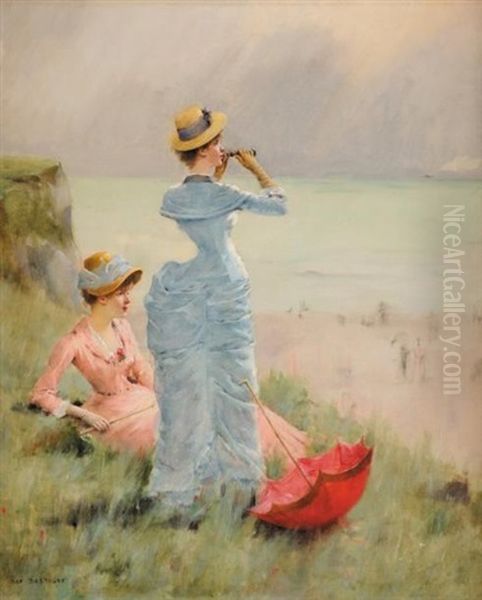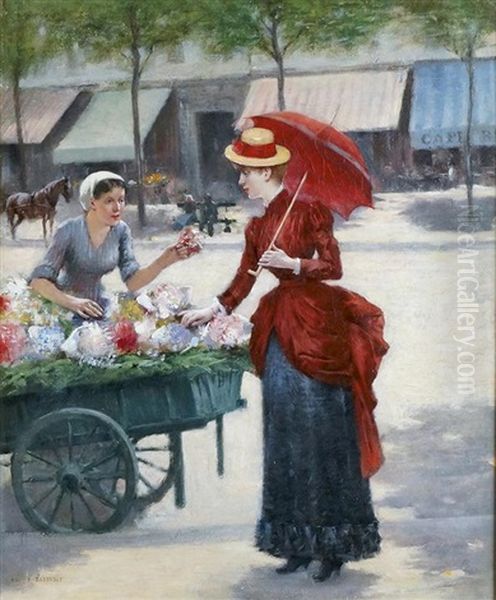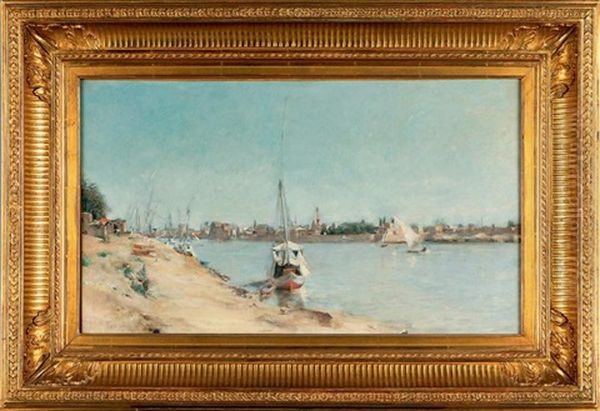Maxime Dastugue (1851-1909) was a French artist whose career unfolded during a vibrant and transformative period in European art. Though perhaps not as widely recognized today as some of his contemporaries, Dastugue was a dedicated painter who carved out a niche for himself, particularly within the popular genre of Orientalism. His work reflects the academic training of the time, the profound influence of his celebrated master, and the pervasive European fascination with the cultures and landscapes of the "Orient."
Early Life and Artistic Formation
Born in 1851 in Castelnau-Magnoac, a commune in the Hautes-Pyrénées department in southwestern France, Maxime Dastugue's early life set the stage for an artistic career steeped in the traditions of the French academic system. The rural tranquility of his birthplace stood in contrast to the bustling artistic hub of Paris, where he would later establish his career. Crucially, Dastugue became a student of Jean-Léon Gérôme (1824-1904), one of the most prominent and influential academic painters of the 19th century.
Gérôme's atelier was a magnet for aspiring artists from France and abroad. He was renowned for his meticulously detailed historical scenes, classical subjects, and, significantly, his captivating Orientalist paintings. Gérôme's own extensive travels to Egypt, Turkey, and the Near East provided him with a wealth of firsthand material, which he translated into highly polished and often dramatic canvases. His teaching emphasized rigorous draftsmanship, anatomical accuracy, and a smooth, almost invisible brushwork – hallmarks of the academic style that dominated the official Salons.
Under Gérôme's tutelage, Dastugue would have absorbed these principles. The master's influence is palpable in Dastugue's choice of subject matter and his approach to composition and detail. Like many of Gérôme's pupils, such as the American Frederick Arthur Bridgman or the Ottoman painter Osman Hamdi Bey, Dastugue was drawn to the exotic allure of Orientalist themes, a genre that Gérôme himself had helped to popularize and define.
The Journey to the Orient: Egypt's Enduring Inspiration

A pivotal moment in Maxime Dastugue's artistic development was his journey to the East, specifically to Egypt, around 1889. For European artists of the 19th century, travel to North Africa and the Middle East was almost a rite of passage, particularly for those inclined towards Orientalist subjects. These journeys offered a chance to escape the perceived confines of European civilization and to immerse oneself in cultures, landscapes, and light that seemed to offer endless artistic possibilities. Artists like Eugène Delacroix, a pioneer of French Romantic Orientalism, had blazed this trail earlier in the century, followed by figures such as Eugène Fromentin, Alexandre-Gabriel Decamps, and Théodore Chassériau.
Dastugue's Egyptian sojourn provided him with a rich repository of sketches, memories, and inspirations that would fuel his artistic production for years to come. The vibrant street scenes, the majestic ancient ruins, the unique quality of the desert light, and the daily life of the Egyptian people offered a stark contrast to the familiar environments of France. He returned with a portfolio of impressions and studies, ready to translate these experiences into finished paintings for the Parisian art market. This direct encounter with the "Orient" lent an air of authenticity to his work, a quality highly valued by contemporary audiences.
Orientalism: A Dominant Artistic Current
To understand Maxime Dastugue's work, it is essential to place it within the broader context of 19th-century Orientalism. This artistic and cultural phenomenon was characterized by a Western fascination with the societies and cultures of North Africa, the Middle East, and Asia. Fueled by colonialism, increased travel, archaeological discoveries, and romantic literature, Orientalism manifested in painting, literature, music, and decorative arts.
Painters depicted a wide array of Orientalist themes: bustling souks, serene mosque interiors, harem scenes (often imagined), desert caravans, historical events, and portraits of local figures. While some artists aimed for ethnographic accuracy, others indulged in romanticized or stereotypical portrayals. Jean-Léon Gérôme was a master of the meticulously detailed and often dramatic Orientalist scene, as were his contemporaries like Gustave Boulanger and Benjamin-Constant. Austrian painters active in Paris, such as Ludwig Deutsch and Rudolf Ernst, also became famous for their highly polished and popular depictions of Middle Eastern life.
Dastugue's Orientalism, filtered through the lens of Gérôme's academic precision, tended towards genre scenes and landscapes. He sought to capture the atmosphere and daily rhythms of the places he visited, often imbuing his canvases with a sense of calm and careful observation. His work generally avoided the overt sensuality or violence found in some Orientalist paintings, focusing instead on the picturesque and the everyday.
Dastugue's Artistic Style and Technique

Maxime Dastugue's artistic style was firmly rooted in the academic tradition championed by his teacher, Jean-Léon Gérôme. This approach emphasized strong draftsmanship, a clear and balanced composition, and a high degree of finish. His brushwork was typically smooth and controlled, aiming to create a polished surface where the artist's hand was not overly apparent. This meticulous technique was well-suited to rendering the intricate details of Oriental architecture, textiles, and the varied textures of the landscapes he depicted.
His use of color was often rich and evocative, capturing the intense light and vibrant hues associated with Egyptian and Middle Eastern settings. He paid close attention to the play of light and shadow, using it to model forms and create a sense of depth and atmosphere. Whether depicting figures in a sun-drenched marketplace or the tranquil waters of the Nile, Dastugue demonstrated a keen observational skill and a commitment to verisimilitude, albeit often filtered through a romantic sensibility.
While adhering to academic conventions, Dastugue's paintings also convey a genuine appreciation for the scenes he portrayed. There is a sensitivity in his depictions of local life and a clear fascination with the exotic environments he encountered. His compositions are generally well-structured, guiding the viewer's eye through the scene in a clear and engaging manner.
The Paris Salon and Dastugue's Career
The Paris Salon, officially the Salon de Peinture et de Sculpture, was the most important art exhibition in the Western world during much of the 19th century. Organized by the Académie des Beaux-Arts, acceptance into the Salon was crucial for an artist's reputation and commercial success. It was the primary venue where artists could showcase their work to critics, collectors, and the public.
Maxime Dastugue was a consistent participant in the Paris Salon, exhibiting his works regularly from 1876 to 1908. This long period of participation indicates a sustained career and a degree of acceptance within the official art establishment. His submissions would have included a variety of subjects, but his Orientalist pieces, particularly those inspired by his Egyptian travels, likely garnered significant attention. The Salon audiences of the late 19th century had a strong appetite for exotic scenes, and Dastugue's paintings, with their blend of academic skill and appealing subject matter, would have found a receptive market.

During this era, the Salon was a bastion of academic art, favoring historical paintings, mythological scenes, portraits, and meticulously rendered genre scenes. Artists like William-Adolphe Bouguereau and Léon Bonnat (another influential teacher) were among the stars of the Salon. While Impressionists like Claude Monet and Edgar Degas were challenging academic conventions and exhibiting independently, the Salon remained the dominant force for artists like Dastugue who worked within the established system.
Representative Works of Maxime Dastugue
Several of Maxime Dastugue's works provide insight into his artistic preoccupations and style.
FELOUQUES SUR LE NIL (Felucca on the Nile): Dated 1890, this oil painting (32.5 x 55.5 cm) captures a quintessential Egyptian scene. Feluccas, traditional wooden sailing boats, are a timeless feature of the Nile. Dastugue likely depicted these graceful vessels gliding on the tranquil waters, perhaps against a backdrop of the riverbanks or a luminous sky. Such scenes allowed artists to explore the unique light of Egypt and the serene beauty of its lifeline, the Nile. This work, now in a private collection, would have appealed to the contemporary taste for picturesque and evocative landscapes from distant lands.
Elégantes en bord de rivière (Elegant Women by the Riverside): This oil painting (55.5 x 46 cm) suggests a more European or perhaps a generalized idyllic scene rather than a strictly Orientalist one, unless the "elegant women" are depicted in an exotic setting. If set in Egypt, it might portray European women travelers or local women of high status. The title evokes a sense of leisure and refinement, common themes in genre painting of the period.
Le marché aux fleurs (The Flower Market): Also an oil on canvas (55 x 46 cm), this title points to a vibrant genre scene. Flower markets were popular subjects for artists, offering opportunities to depict bustling crowds, colorful displays, and everyday interactions. If set in an Oriental context, it would have allowed Dastugue to showcase the exotic flora and the lively atmosphere of a Middle Eastern souk.
Portrait de Chéri AMBLARD (Portrait of Chéri Ambard): Created in 1895, this larger oil painting (116 x 88 cm) demonstrates Dastugue's skill in portraiture, a staple of academic artists. The identity of Chéri Ambard is not immediately clear from the provided information, but the commission of a formal portrait suggests a patron of some standing. Dastugue would have applied his academic training to capture a likeness while also conveying the sitter's personality or status.

La Fuite en Egypte (The Flight into Egypt): This work, depicting the biblical scene of the Holy Family's escape to Egypt, became widely known through its reproduction as postcards and magazine illustrations in the 1910s and 1920s. This subject allowed Dastugue to combine a traditional religious theme with his interest in Egyptian landscapes and settings, lending an air of authenticity to the biblical narrative. The popularity of its reproductions speaks to its accessibility and appeal to a broad audience.
These works, varying in subject from landscape and genre to portraiture and religious scenes, highlight Dastugue's versatility within the academic framework. His Orientalist paintings, however, remain his most characteristic contribution.
Dastugue in the Context of His Contemporaries
While Dastugue operated within the circle of academic Orientalists, it's useful to consider him alongside other artists of his time. His teacher, Gérôme, was a towering figure, but many other artists explored similar themes. Gustave Guillaumet, for instance, focused on the landscapes and people of Algeria with a particular sensitivity and often a more naturalistic light than the polished finish of Gérôme. Jean Discart, another Orientalist, was known for his detailed scenes of Moroccan life.
The broader art world was also in flux. The Impressionists had already made their mark, and Post-Impressionist movements were emerging. Artists like Paul Gauguin were seeking their own forms of "exoticism" in places like Tahiti, far removed from the academic Orientalism of Dastugue. However, the Salon system and the taste for academic art remained strong throughout Dastugue's career, providing a consistent platform for his work. His adherence to academic principles ensured a degree of success and recognition within this sphere, even if it meant he was not part of the avant-garde movements that would later dominate art historical narratives.
Legacy and Conclusion
Maxime Dastugue passed away in 1909. His artistic output, particularly his Orientalist paintings, contributes to the rich tapestry of 19th-century European art. As a student of Jean-Léon Gérôme, he inherited a tradition of meticulous craftsmanship and a fascination with the East. His journey to Egypt provided firsthand inspiration that infused his work with a sense of place and atmosphere.
While Dastugue may not have achieved the same level of fame as his master or some of the more innovative artists of his era, his work is representative of a significant and popular artistic trend. His paintings offer a window into the 19th-century European perception of the Orient, characterized by a blend of romanticism, ethnographic interest, and a desire for the picturesque. His consistent participation in the Paris Salon over three decades attests to a dedicated professional career and an ability to connect with the artistic tastes of his time.
Today, the works of Maxime Dastugue and other academic Orientalists are re-evaluated not only for their artistic merit but also for their cultural and historical significance. They reflect a specific moment in the complex relationship between Europe and the Middle East, and they continue to captivate viewers with their detailed renderings of far-off lands and bygone eras. Dastugue remains a noteworthy figure among the many talented artists who contributed to the diverse and dynamic art scene of late 19th-century France.